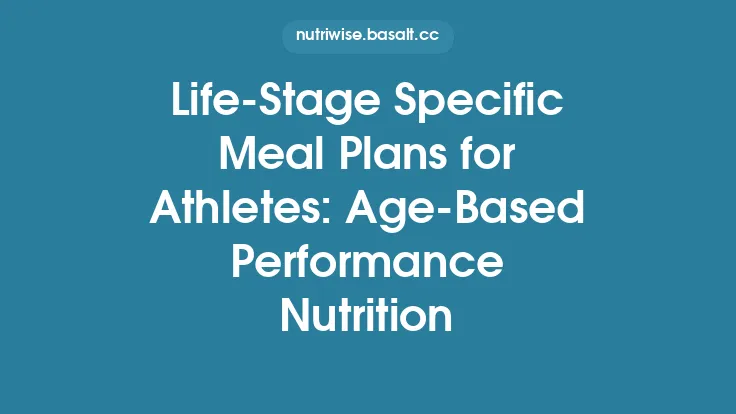Mid‑life brings a unique blend of physiological changes, lifestyle demands, and health goals. While the body’s basal metabolic rate (BMR) naturally begins to decline after the late twenties, the rate of this decline can be moderated through thoughtful nutrition and lifestyle choices. Adults aged 30‑50 often juggle demanding careers, family responsibilities, and social commitments, making flexible yet nutrient‑dense meal planning essential. This article delves into the science behind mid‑life metabolism, outlines the nutritional priorities for this age group, and provides practical, evergreen meal‑planning tools that can be adapted to a variety of personal goals—from weight maintenance to muscle preservation and chronic‑disease prevention.
Understanding Metabolic Shifts in Mid‑Life
Basal Metabolic Rate (BMR) Trends
- Age‑related decline: BMR typically drops about 1‑2 % per decade after age 30, largely due to loss of lean muscle mass (sarcopenia) and hormonal adjustments.
- Hormonal influences: Levels of growth hormone, testosterone, and estrogen gradually decrease, affecting protein synthesis and fat oxidation.
- Insulin sensitivity: Many adults experience a modest reduction in insulin sensitivity, which can predispose them to higher circulating glucose and triglyceride levels if diet is not optimized.
Energy Expenditure Components
- Resting Energy Expenditure (REE): The largest component, driven by organ function and lean tissue.
- Thermic Effect of Food (TEF): Approximately 10 % of total calories; higher protein intake raises TEF.
- Physical Activity Energy Expenditure (PAEE): Highly variable; regular resistance training can offset BMR decline by preserving muscle mass.
Implications for Meal Planning
- Protein becomes a priority to support muscle maintenance and increase TEF.
- Fiber‑rich carbohydrates help modulate post‑prandial glucose spikes, supporting insulin sensitivity.
- Healthy fats (especially omega‑3 fatty acids) aid in anti‑inflammatory pathways and hormone synthesis.
Key Nutritional Priorities for Adults 30‑50
| Nutrient | Why It Matters | Recommended Daily Intake* |
|---|---|---|
| Protein | Preserves lean mass, supports satiety, boosts TEF | 0.8‑1.2 g/kg body weight (≈ 56‑84 g for a 70 kg adult) |
| Fiber | Improves gut health, regulates blood sugar, lowers LDL cholesterol | 25‑38 g (women ≈ 25 g, men ≈ 38 g) |
| Omega‑3 (EPA/DHA) | Anti‑inflammatory, supports cardiovascular health, aids brain function | 250‑500 mg combined EPA/DHA |
| Calcium & Vitamin D | Bone density maintenance, muscle contraction | Calcium ≈ 1,000 mg; Vitamin D ≈ 600‑800 IU |
| Magnesium | Energy production, sleep quality, stress response | 310‑420 mg |
| Potassium | Blood pressure regulation, electrolyte balance | 4,700 mg |
| Antioxidants (vitamins C, E, selenium) | Counteract oxidative stress associated with aging | Varies; aim for a colorful, plant‑rich diet |
\*Intakes are general guidelines; individual needs may vary based on activity level, health status, and body composition goals.
Macronutrient Balance and Energy Needs
- Determine Caloric Baseline
- Use the Mifflin‑St Jeor equation to estimate BMR, then multiply by an activity factor (1.2‑1.55 for most moderately active adults).
- Example for a 40‑year‑old, 70 kg, 175 cm male with moderate activity:
- BMR ≈ 10 × 70 + 6.25 × 175 − 5 × 40 + 5 = 1,660 kcal
- Total Energy Expenditure (TEE) ≈ 1,660 × 1.4 ≈ 2,324 kcal/day
- Set Macro Ratios
- Protein: 20‑30 % of total calories (≈ 115‑175 g)
- Fat: 25‑35 % (≈ 65‑90 g), emphasizing monounsaturated and polyunsaturated fats
- Carbohydrates: 45‑55 % (≈ 260‑320 g), focusing on complex carbs and fiber‑rich sources
- Adjust for Goals
- Weight loss: Create a modest 10‑20 % calorie deficit while preserving protein intake.
- Muscle gain/maintenance: Slightly increase protein (up to 1.5 g/kg) and ensure adequate total calories.
- Metabolic health: Prioritize low‑glycemic carbs, increase omega‑3s, and limit added sugars.
Micronutrient Focus Areas
- Bone Health: Calcium‑rich foods (low‑fat dairy, fortified plant milks, leafy greens) paired with vitamin D sources (fatty fish, fortified eggs, sunlight exposure).
- Cardiovascular Support: Magnesium‑rich nuts, seeds, whole grains; potassium‑dense fruits and vegetables (bananas, avocados, sweet potatoes).
- Stress & Sleep: B‑vitamin complex from whole grains, legumes, and lean meats; magnesium from pumpkin seeds and dark chocolate (70 %+ cacao).
- Immune Resilience: Vitamin C from citrus, berries, and bell peppers; zinc from oysters, chickpeas, and pumpkin seeds.
Meal Timing and Frequency
| Approach | Potential Benefits | Practical Tips |
|---|---|---|
| Three Balanced Meals + 1‑2 Snacks | Stable blood glucose, easier portion control | Include protein in each meal; snack on nuts, Greek yogurt, or fruit with nut butter. |
| Time‑Restricted Eating (e.g., 10‑hour window) | May improve insulin sensitivity and support circadian rhythm | Ensure nutrient density within the eating window; stay hydrated during fasting periods. |
| Pre‑ and Post‑Workout Nutrition | Optimizes muscle protein synthesis and glycogen replenishment | Pre‑workout: 20‑30 g carbs + 10‑15 g protein 30‑60 min before; Post‑workout: 20‑30 g protein + 30‑50 g carbs within 2 hr. |
Consistency is more important than strict adherence to a single pattern. Choose a schedule that aligns with work, family, and social commitments.
Sample One‑Week Meal Plan
Day 1
- Breakfast: Greek yogurt parfait (200 g plain Greek yogurt, ½ cup mixed berries, 2 Tbsp granola, 1 Tbsp chia seeds) – 350 kcal
- Snack: Apple slices with 1 Tbsp almond butter – 180 kcal
- Lunch: Quinoa‑black bean bowl (¾ cup cooked quinoa, ½ cup black beans, ½ cup roasted veggies, 2 Tbsp salsa, 1 oz feta) – 520 kcal
- Snack: Hard‑boiled egg + a handful of baby carrots – 120 kcal
- Dinner: Baked salmon (150 g) with lemon‑dill sauce, side of sautéed kale (1 cup) and sweet‑potato mash (½ cup) – 560 kcal
Day 2
- Breakfast: Overnight oats (½ cup rolled oats, ½ cup unsweetened almond milk, 1 Tbsp peanut butter, ½ banana sliced, 1 Tbsp flaxseed) – 380 kcal
- Snack: Cottage cheese (½ cup) with pineapple chunks (¼ cup) – 130 kcal
- Lunch: Turkey and avocado wrap (whole‑grain tortilla, 3 oz sliced turkey breast, ¼ avocado, lettuce, tomato, mustard) – 440 kcal
- Snack: Trail mix (¼ cup mixed nuts & dried fruit) – 200 kcal
- Dinner: Stir‑fried tofu (120 g) with broccoli, bell peppers, snap peas, and brown rice (¾ cup) – 540 kcal
*(Continue with similar balanced patterns for Days 3‑7, rotating protein sources (chicken, lean beef, legumes, fish), carbohydrate choices (whole‑grain pasta, barley, lentils), and vegetable varieties to ensure nutrient diversity.)*
Key Features of the Sample Plan
- Protein in every main meal (≥ 20 g) to sustain muscle mass.
- Fiber ≥ 25 g/day through fruits, vegetables, legumes, and whole grains.
- Healthy fats from nuts, seeds, avocado, and fatty fish.
- Balanced micronutrient profile achieved by color‑rich produce and fortified dairy alternatives.
Grocery Shopping Guide
| Category | Core Items | Portion‑Size Tips |
|---|---|---|
| Proteins | Skinless chicken breast, wild‑caught salmon, canned tuna in water, extra‑firm tofu, Greek yogurt, eggs, lentils, chickpeas | Buy in bulk packs; freeze portions of meat/fish; pre‑portion beans into freezer bags. |
| Whole Grains | Quinoa, brown rice, steel‑cut oats, whole‑grain pasta, whole‑wheat tortillas | Store in airtight containers; measure dry portions (½ cup dry ≈ 1 cup cooked). |
| Vegetables | Leafy greens (spinach, kale), cruciferous (broccoli, cauliflower), colorful peppers, carrots, sweet potatoes, onions, garlic | Choose a mix of fresh and frozen for convenience; pre‑wash and chop for quick use. |
| Fruits | Berries, apples, bananas, citrus, grapes | Keep a fruit bowl visible; freeze berries for smoothies. |
| Healthy Fats | Extra‑virgin olive oil, avocado, mixed nuts, seeds (chia, flax, pumpkin) | Use measured spoons for cooking; snack‑size nut packs for portability. |
| Dairy/Alternatives | Low‑fat milk or fortified plant milks, cheese, cottage cheese | Opt for calcium‑fortified options if dairy‑free. |
| Spices & Condiments | Turmeric, cumin, smoked paprika, low‑sodium soy sauce, mustard, balsamic vinegar | Enhance flavor without excess sodium or added sugars. |
Budget‑Friendly Strategies
- Seasonal produce reduces cost and maximizes flavor.
- Bulk legumes (dry beans, lentils) are inexpensive protein sources.
- Store‑brand items often match quality of name brands.
- Plan for leftovers: Cook a larger batch of a grain or protein and repurpose it in salads, wraps, or stir‑fries.
Practical Tips for Meal Prep and Sustainability
- Batch‑Cook Staples
- Cook a large pot of quinoa or brown rice on Sunday; store in the fridge for up to 5 days.
- Roast a sheet pan of mixed vegetables (olive oil, herbs) for quick side dishes.
- Portion‑Control Containers
- Use divided containers (e.g., ½ cup protein, 1 cup carbs, 1 cup veg) to streamline lunch assembly.
- One‑Pot/One‑Pan Recipes
- Reduce cleanup time with sheet‑pan salmon with veggies, or a skillet chili with lean ground turkey and beans.
- Freezer‑Friendly Meals
- Prepare freezer‑ready soups, stews, and casseroles in individual portions; label with date and reheating instructions.
- Mindful Eating Practices
- Eat without distractions, chew thoroughly, and pause between bites to gauge satiety.
- Technology Aids
- Use nutrition‑tracking apps to log meals and ensure macro targets are met.
- Set calendar reminders for grocery trips and prep days.
Adapting Plans to Individual Goals
| Goal | Adjustments |
|---|---|
| Weight Loss | Create a 10‑15 % calorie deficit; increase non‑starchy veg volume; keep protein at the higher end of the range. |
| Muscle Preservation/Gain | Raise protein to 1.2‑1.5 g/kg; add a post‑workout protein shake (20‑30 g whey or plant protein). |
| Improving Blood Lipids | Emphasize omega‑3 sources, replace saturated fats with monounsaturated fats, limit refined carbs and added sugars. |
| Managing Pre‑diabetes | Prioritize low‑glycemic carbs (legumes, whole grains), spread carbohydrate intake evenly across meals, incorporate vinegar or lemon juice to blunt glucose spikes. |
| Busy Professionals | Opt for “grab‑and‑go” options like pre‑portioned nuts, protein bars with ≤ 10 g sugar, and ready‑to‑heat meals made from batch‑cooked components. |
Regularly reassess goals (every 4‑6 weeks) and adjust portion sizes, macro ratios, or food choices accordingly.
Monitoring Progress and Making Adjustments
- Objective Metrics
- Weight & Body Composition: Use a scale and, if possible, a body‑fat analyzer every 2‑4 weeks.
- Blood Markers: Annual lipid panel, fasting glucose, and vitamin D levels provide insight into metabolic health.
- Subjective Indicators
- Energy levels throughout the day, sleep quality, hunger cues, and digestive comfort.
- Feedback Loop
- If weight stalls while body‑fat decreases, consider a modest calorie reduction.
- Persistent fatigue may signal inadequate micronutrients (e.g., iron, B12) or insufficient sleep; adjust diet and lifestyle accordingly.
- Professional Support
- Registered dietitians can personalize macro calculations and address specific health conditions.
- Fitness professionals can align nutrition with exercise programming for optimal results.
Closing Thoughts
Mid‑life is a pivotal window for establishing dietary habits that sustain health well into later decades. By understanding the subtle metabolic shifts that occur between ages 30 and 50, prioritizing protein, fiber, and essential micronutrients, and employing flexible yet structured meal‑planning strategies, adults can maintain a healthy body composition, support cardiovascular and bone health, and preserve the energy needed for work, family, and recreation. The evergreen principles outlined here—balanced macros, nutrient density, mindful timing, and adaptable preparation—provide a solid foundation that can be customized to any personal goal or lifestyle constraint, ensuring that nutrition remains a reliable ally throughout the dynamic years of adulthood.





